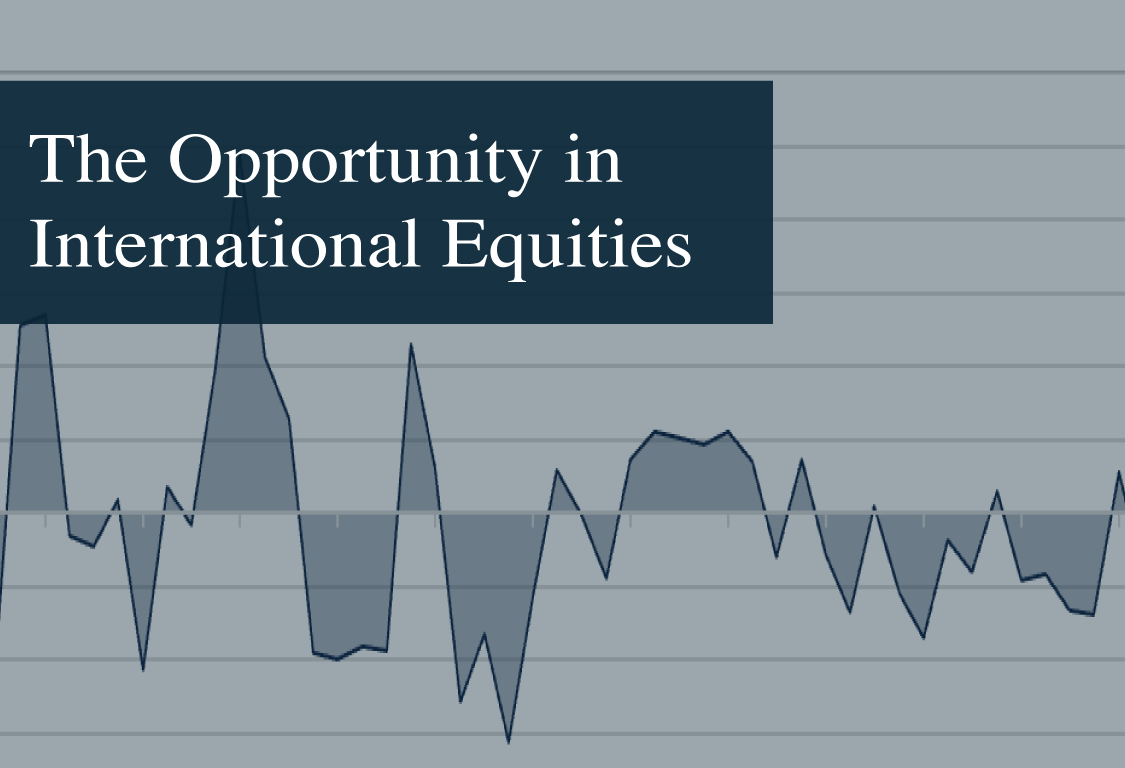In a 2020 piece titled, “Why International, Why Now?” we laid out the case for adding international equities to a portfolio. Diversification is typically the main driver for adding international exposure to portfolios. Beyond diversification, the opportunity set is three times larger for international and the U.S. does not have a monopoly on world class companies1. Secondly, market leadership has alternated between U.S. and international markets and once a market starts to move it tends to hold that leadership, averaging six years per run. As shown on the graph below, the current 14-year period (with a few small rallies) is the longest period for international returns to lag U.S. returns since 19702.

While there is no time limit on market leadership, repeated under-performance tends to manifest into a higher degree of negative investment sentiment toward the under-performing asset class. The negative sentiment reinforces the fact that expectations are low, which justifies the valuation derating. This phenomenon leads to the third reason to consider adding international exposure to a portfolio: as shown in the table below, international companies are inexpensively valued relative to US counterparts3.

The table above compares some fundamental and valuation data between 2020 and 2024. The valuation measures (Trailing P/E, EV/EBITDA, and EV/Sales) suggest that international markets are relatively cheaper than the U.S. market from an index perspective, even while metrics such as the change in operating margins between the two periods show international companies generating greater improvement relative to the U.S.
To summarize, we believe now is a good time to consider international equity exposure in a portfolio. In our opinion, the U.S. market outperformance appears extended relative to the historical norm and international equities are relatively inexpensive, reflecting depressed market expectations-especially compared to U.S. equities. The pending requirement, in our view, is a catalyst to spark a change in leadership, which is exceedingly difficult to time.
What’s with the protracted cycle of U.S. dominance?
In our opinion, three events have perpetuated the continued run of superior U.S. returns relative to international: the pandemic, the Russian invasion of Ukraine, and the artificial intelligence (AI) hype of late 2023/24. Both U.S. and international markets experienced the full extent of the pandemic, but the U.S. market benefitted from a larger technology weight in the index, which helped it to maintain leadership as the demand for a variety of tech products skyrocketed to equip work-from-home offices4. U.S. markets appeared to hit a high in late 2021 (historically an indicator of leadership change) but then the next event took place, the Russian invasion of Ukraine (February 2022). While rising energy price pressures were felt globally, costs zoomed highest in Europe as most EU states attempted to move away from cheap Russian energy5. High energy prices crushed profit margins for European industrial companies and required consumers to divert discretionary spending to necessities as general inflation pressures broadened. U.S. companies and consumers did suffer these ill effects but in a much more limited way. Ironically, international markets fell far enough in mid-2022 that it appeared a leadership change might be on the horizon. However, by mid-2023 the U.S. market wrestled back leadership paving the way for the last event, the massive run in all things AI, where the U.S. has much more exposure.
Structurally, International equities by nature are riskier than domestic equities. Currency risk is an added feature to consider since international equities are priced in the currency of their home market, which can move independently of any stock price movements. This can enhance or detract from an equity’s return when translated back into U.S. dollars. Secondly, international equities are generally less liquid than U.S. equities. Investors are willing to pay a higher price for liquidity and part of the premium U.S. valuation we observe may be due to this liquidity preference. Finally, on top of the additional risk, the strong run in U.S. returns for more than a decade may also reinforce home country bias, the tendency for investors to favor companies found in their local market.
No one rings a bell when market leadership changes take place and trying to time one is a fool’s errand. Historically these large diversions in investment results and valuations reinforce the need to be mindful of diversification and regression to the mean. As value investors, we believe the real opportunity lies in these extremes.
Our Investment Framework at VELA
At VELA, our focus is active security selection of companies which meet our valuation requirements, those trading below our estimate of intrinsic value plus the incorporation of an adequate margin of safety. The international portfolio is built from the bottom-up, seeking opportunities across the market capitalization spectrum: we go where we see value. As part of the selection process, we seek companies with balance sheet strength and prefer those which pay a current dividend. We also like to find management teams who have demonstrated the ability to properly allocate capital, usually identified by high or improving returns on invested capital.
Much of the discussion has been focused on the top-down attractiveness of international equity markets. Our focus is bottom-up and we are lucky to have an opportunity set which is three times larger than what is found in the United States1. Below are three examples of international companies compared against their respective U.S. peer(s) which demonstrate the value found looking outside the U.S. This is by no means an exhaustive list.
Michelin (FR) vs Goodyear (US)
What makes tire manufacturing an attractive business is the indifference to how vehicles are powered; they all roll on tires. Michelin is the leading tire manufacturer by market share in the world and trades on the French equity market while Goodyear is the number three global player and headquartered in Akron, OH.

By our estimation, the figures for Michelin are superior to those of Goodyear. Better returns on invested capital, better margins, and better sales growth may be reflected in better multiples and superior stock appreciation over the long run, but the current and average P/E of Michelin trades at a discount to Goodyear.
B&M Euro Value Retail (UK) vs Dollar General (US)
Both companies are discount retailers. The B&M business model is like the model employed by Dollar General, but B&M is earlier in its life cycle. Dollar General has also released disappointing earnings results recently, which may hurt current comparisons so focus should fall on the average figures.

The UK economy has seen sub-par growth since Brexit. The discount concept in the UK is not as well advanced as in the U.S., but is becoming a more desirable option for consumers given the attractive value proposition offered by B&M. The two companies’ averages of return on invested capital and operating margins fall in the same ballpark but the current levels suggest B&M may see these averages improve going forward, assuming current trajectory is maintained. However, the P/E multiple is lower for B&M and the dividend yield is much higher. The combination of these factors makes it, in our opinion, the better value.
TotalEnergies (FR) vs Chevron (U.S.) vs Exxon (U.S.)
The respective business lines (i.e., upstream, downstream, chemicals, etc.) of these three global super-major energy companies may not line up exactly, but the biggest difference between the three companies is that TotalEnergies has its primary listing and headquarters in France, the latter two in the U.S.

All three have similar returns on invested capital and the average sales growth also falls in a similar range. The major difference is the discount on the multiple of earnings (P/E) and the multiple of operating cash flow (EV/EBITDA) between the French-traded and U.S-traded companies. Should TotalEnergies trade at a 40% discount to both P/E or EV/EBITDA multiples to the two U.S. companies today (or a 30% discount on each
measures vs the averages)? It appears the market is pricing in additional risk (more so than outlined above) to the earnings and cash flow streams of TotalEnergies given the large discount in its stock price relative to the U.S. players. The differing valuations prompted TotalEnergies CEO, Patrick Pouyanne, to explore dually-listing shares in New York, which should make it more attractive to U.S. investors9.
These are just three bottom-up examples of international companies with prospects which, in our view, are equal or better than those of U.S. peers: each of which trades at a discount we believe sufficient to compensate investors for the additional risk taken. While a bell will never ring to signal a leadership change from U.S. to international markets, we believe now is a good time to add international equity exposure to your portfolio. At VELA, our active management can work to navigate the inherent volatility, risk, and opportunities in international equities, and we are confident in the relative risk adjusted returns our adherence to our disciplined investment process has enabled us to deliver since the inception of the fund.
Disclosures:
Investors should carefully consider the investment objectives, risks, and charges and expenses of the fund before investing. The prospectus contains this and other information about the fund, and it should be read carefully before investing. Investors may obtain a copy of the prospectus by calling 833-399-1001.
The fund is distributed by Ultimus Fund Distributors, LLC. (Member FINRA). VELA Investment Management, LLC and Ultimus Fund Distributors, LLC are not affiliated.
Performance data quoted represents past performance. Past performance does not guarantee future results. The investment return and principal value of an investment will fluctuate so that an investor’s shares, when redeemed, may be worth more or less than their original cost. Current performance may be lower or higher than the performance data quoted. Investors may obtain performance data current to the most recent month-end by calling 833-399-1001.
As of 9.30.24, Annualized Total Return for the VELA International Fund, Class I Shares 1-year was 19.69%, 3-year was 6.44%, and since inception (09.30.2020) was 10.49%.
The expense ratio of the VELA International Fund (Class I) is 1.12%.
Current and future portfolio holdings are subject to risk. A complete list of portfolio holdings can be found at www.velafunds.com.
The VELA International Fund objective is to provide long term capital appreciation.
Important Risk Information: An investment in the Fund involves risk, including possible loss of principal. The principal risks of investing in Funds include equity, market, management and non-diversification risks. The market value of a security or instrument may decline due to general market conditions that are not specifically related to a particular company, such as real or perceived adverse economic conditions, changes in the general outlook for corporate earnings, changes in interest or currency rates or adverse investor sentiment generally.
The fund may not achieve its objective and/or you could lose money on your investment in the fund. Stock markets and investments in individual stocks are volatile and can decline significantly in response to market, foreign securities, small company, investment style and management risks.
The VELA International Fund invests in a diversified portfolio of non-U.S. equities from a broad market capitalization spectrum. The fund may invest in non-U.S. securities and U.S. securities of companies domiciled in non-U.S. countries that may experience more rapid and extreme changes in value than a fund that invests exclusively in securities of U.S. companies. These companies may be subject to additional risks, including political and economic risks, civil conflicts and war, greater volatility, expropriation and nationalization risks, currency fluctuations, regulatory risk, higher transaction costs, delayed settlement, possible non-U.S. controls on investments, and less stringent investor protection and disclosure standards of U.S. markets.
Diversification neither assures a profit nor guarantees against loss.
The views expressed are those of VELA Investment Management, LLC as of October 30, 2024 and are subject to change. These opinions are not intended to be a forecast of future events, a guarantee of future results, or investment advice. Third-party information in this report has been obtained from sources believed to be accurate; however, VELA makes no guarantee as to the accuracy or completeness of the information.
The MSCI World ex USA Index captures large and mid-cap representation across 22 of 23 Developed Markets (DM) countries excluding the United States. You cannot invest directly into an index.
The MSCI USA Index is designed to measure the performance of the large and mid cap segments of the US market.
Intrinsic Value is a measure of what an asset is worth, arrived at by means of an objective calculation or complex financial model. Intrinsic value is different from the current market price of an asset. However, comparing it to that current price can give investors an idea of whether the asset is undervalued or overvalued.
The Return on Invested Capital (ROIC) measures the percentage return of profitability earned by a company using the capital contributed by equity and debt providers. Conceptually, the return on invested capital (ROIC) is a measure of value creation.
The price-to-earnings (P/E) ratio measures a company’s current share price relative to its per-share earnings.
The operating margin measures the profit a company makes on a dollar of sales after accounting for the direct costs involved in earning those revenues.
Dividend yield is a ratio, and one of several measures that helps investors understand how much return they are getting on their investment.
Sales growth is a metric that measures the ability of a company to increase revenue over a fixed period of time.
Free cash flow yield indicates the amount of cash generated each year that is free and clear of all internal or external obligations. This is cash that a company can safely invest or distribute to shareholders.
EV/EBITDA is a ratio of operating and non-operating profits compared to the market value of a company’s equity plus its debt.
EV/Sales is a financial ratio that measures a company’s total value (in enterprise value terms) to its total sales revenue.
Enterprise Value/EBITDA is a financial metric that compares a company’s value to its earnings.
Footnotes:
1There are over 8,000 companies world-wide with market capitalizations over $1 billion, with three-quarters of these being internationally domiciled; the other quarter are found in the U.S. However, more companies to consider requires additional effort to uncover the best opportunities. (Source: Bloomberg).
2International Returns are represented by the MSCI World ex USA Index, M1WOU, while U.S. returns are represented by the MSCI USA Index, M1US. (Source: Bloomberg, Chart: VELA Investment Management, LLC).
3International data is represented by the MSCI World ex USA Index, M1WOU, while U.S. data is represented by the MSCI USA Index, M1US. (Source: Bloomberg). ‘Relative’ shows international data compared to U.S. data, calculated by dividing the relevant international index data point by the U.S. index data point.
4,5,6,7,8Source: Bloomberg
9Reuters
Author

Bob Sharpe
Jun 16, 2020


